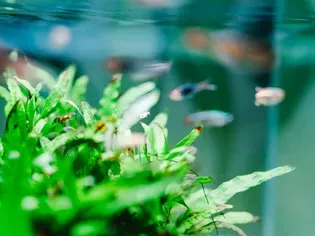How to Clean Algae From Aquarium Plants
Updated on 04/26/24

Unveiling the Secrets: A Comprehensive Guide to Eradicating Algae from Aquarium Plants
Battling algae infestations in your aquarium can be a daunting task, but with the right knowledge and techniques, you can restore the pristine beauty of your aquatic haven. In this comprehensive guide, we will delve into the depths of algae removal, providing you with a step-by-step approach to effectively clean your aquarium plants and prevent future outbreaks.
Understanding the Green Foe: Types of Algae in Aquariums
Before embarking on our algae-busting mission, it is essential to identify the specific type of algae plaguing your aquarium. Different species exhibit unique characteristics, and tailoring your treatment strategy accordingly will enhance its effectiveness.
* Green Algae: The most common type, green algae form unsightly green patches or filaments on plant surfaces.
* Brown Algae: Often referred to as diatoms, brown algae appear as a thin, brown film on plants, glass, and other surfaces.
* Red Algae: This stubborn type of algae manifests as red or pink tufts or slimy patches.
* Black Beard Algae: As its name suggests, black beard algae forms dense, hair-like clusters that can suffocate plants.
* Cyanobacteria (Blue-Green Algae): Contrary to its name, cyanobacteria are not algae but bacteria that form unsightly blue-green or black mats.
Targeted Treatment: Addressing Different Algae Types
Once you have identified the type of algae present, you can tailor your treatment plan to effectively combat the infestation.
Green Algae Removal:
* Hydrogen Peroxide: Dilute 3% hydrogen peroxide in a 1:1 ratio with water and apply directly to algae spots. Leave for 10 minutes before rinsing.
* Algae Scrapers: Gently scrape algae off plant surfaces using a dedicated algae scraper. Avoid damaging the plants.
* UV Sterilizers: These devices emit ultraviolet light that kills algae cells. Consider using one in conjunction with other methods.
Brown Algae Removal:
* Nutrient Reduction: Reduce nutrient levels in the water by performing water changes and limiting fertilizer use.
* Algae-Eating Creatures: Introduce algae-eating animals such as snails, shrimp, or Otocinclus catfish into your aquarium.
* Silicate Remover: Use a silicate remover to reduce the silica levels in the water, which diatoms thrive on.
Red Algae Removal:
* Erythromycin: This antibiotic can be effective against red algae but may harm beneficial bacteria. Use with caution.
* Hydrogen Peroxide: Apply diluted hydrogen peroxide directly to the algae. Be careful not to overdose, as it can harm plants.
* Manual Removal: Physically remove red algae by hand or with a pair of tweezers.
Black Beard Algae Removal:
* Excel (Glutaraldehyde): This chemical kills black beard algae but can be harmful to plants. Use according to the manufacturer's instructions.
* Manual Removal: Carefully remove the algae by hand, using a sharp object to cut and remove the strands.
* Hydrogen Peroxide: Apply diluted hydrogen peroxide to the base of the algae. Avoid getting it on the leaves of the plants.
Cyanobacteria Removal:
* Antibiotics: Erythromycin or erythromycin/sulfathiazole can be effective against cyanobacteria. Use with caution.
* Hydrogen Peroxide: Apply diluted hydrogen peroxide to the cyanobacteria. Repeat treatment daily until the infestation subsides.
* UV Sterilizers: UV light kills cyanobacteria effectively. Use in conjunction with other methods for best results.
Prevention: Safeguarding Your Aquarium from Algae
Once you have successfully eliminated algae from your aquarium plants, it is crucial to implement preventative measures to minimize the risk of future outbreaks.
* Regular Water Changes: Perform regular water changes (20-25% weekly) to remove excess nutrients and waste.
* Avoid Overfeeding: Overfeeding leads to increased nutrient levels and algae growth. Feed your fish only what they can consume in a few minutes.
* Adequate Filtration: Invest in a high-quality filter system to remove particles and waste effectively.
* CO2 Injection: Injecting CO2 into the water helps plants thrive, making them less susceptible to algae growth.
* Control Lighting: Limit the duration and intensity of lighting to prevent excessive algae growth.
Conclusion
Cleaning algae from aquarium plants is a multifaceted endeavor that requires a tailored approach based on the type of algae present. By understanding the different species, employing targeted treatment methods, and implementing preventative measures, you can effectively combat algae infestations and restore the vibrant beauty of your aquatic ecosystem. Remember, consistency and patience are key to maintaining a healthy and algae-free aquarium.
Explore More Pets

Freshwater Aquarium Filters
How to Deal With Cloudy Aquarium Water

Saltwater Aquarium Filters
How Do You Remove Chloramines From Tap Water?

Freshwater Aquariums & Habitat
Can I Keep My Koi Fish Inside?

Saltwater Aquariums & Habitat
14 Best Floating Plants for Your Aquarium

Freshwater Fish Health
How to Treat Ich on Freshwater Fish

Saltwater Fish Health
Fin Rot in Aquarium Fish

Freshwater Aquarium Filters
How to Do Aquarium Water Changes

Saltwater Fish Health
How Do Fish Get Parasites?